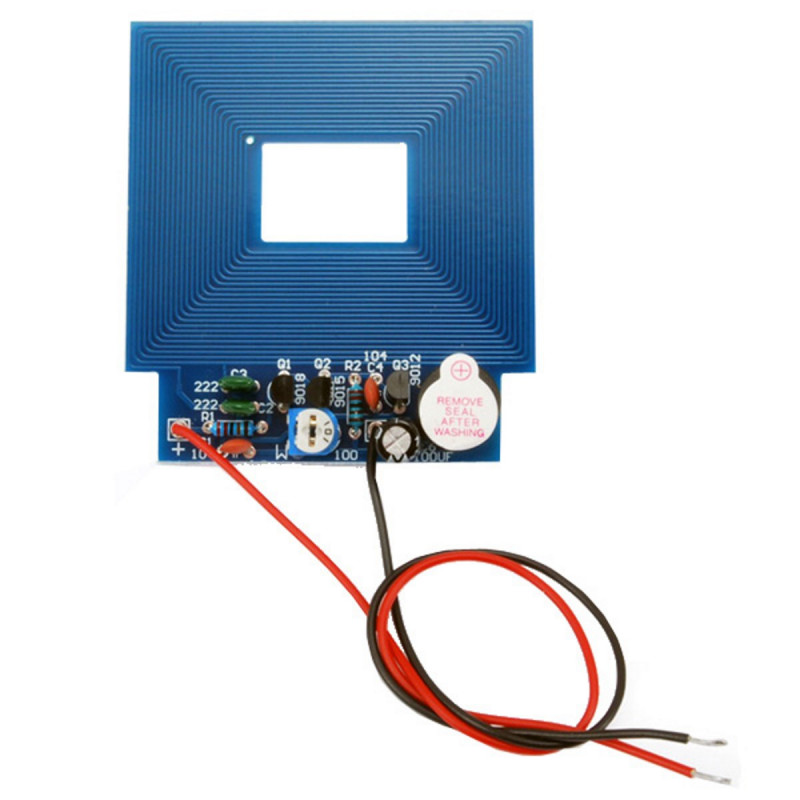





Mit diesem Kit können Sie einen kleinen Metalldetektor erstellen, der Metallobjekte in einem maximalen Abstand von 5 cm erkennen kann.
 Sichere Zahlungen
Sichere Zahlungen
Bezahlen Sie sicher mit Kreditkarte, PayPal, Amazon Pay oder Banküberweisung
 Schneller Versand
Schneller Versand
Wir liefern in ganz Europa und weltweit mit UPS, DHL und DPD
 Einfache Rückgabe in 30 Tagen
Einfache Rückgabe in 30 Tagen
Sie haben 30 Tage ab Lieferung Zeit, das Produkt zurückzugeben, wenn Sie nicht zufrieden sind
Attenzione, il prodotto è un KIT e pertanto vi verranno consegnati i componenti da saldare con un saldatore per elettronica e tutto l'occorrente per ricreare l'apparato come da immagine. Nel KIT sono comprese istruzioni illustrate in lingua inglese di facile comprensione.
LIVELLO ESPERIENZA NECESSARIO medio-basso
Disponibile anche il montaggio e collaudo da parte di Mectronica STORE aggiungendo quantità 10 del Servizio montaggio KIT acquistabile cliccando qui su EBAY | MECTRONICA STORE ed aggiungendolo al carrello insieme al KIT da montare.
Questo kit permette di realizzare un piccolo metal detector in grado di rilevare oggetti metallici ad una distanza massima di 5 cm. Alimentazione: da 3 a 9 VDC, dimensioni (mm): 66x61x15, trimmer per la regolazione della distanza di rilevamento.
Elenco Componenti
Funzionamento
Una volta completate le saldature, tagliate le eccedenze dei terminali e verificato che tutto sia a posto, potete già utilizzare il vostro metal-detector, visto che l’unica taratura, ossia quella del trimmer, si esegue “sul campo”, cioè provando ad avvicinare il circuito (alimentato con una pila da 9V) a delle parti metalliche e ruotando il cursore fin quando non si sente il suono uscire dl cicalino. In vero il trimmer si può registrare anche con degli strumenti e, nello specifico, con un oscilloscopio, collegando la sonda di quest’ultimo tra la massa (negativo di alimentazione) e il collettore del transistor Q1 e verificando quando, ruotando il cursore del trimmer, si sviluppa la sinusoide corrispondente all’oscillazione (se il circuito non oscilla il collettore avrà un potenziale costante…) e cercando di ottenere la massima ampiezza.
Attention, the product is a KIT and therefore you will be given the components to be welded with an electronic soldering iron and everything you need to recreate the apparatus as shown in the image. The KIT includes easy-to-understand illustrated instructions in English.
EXPERIENCE LEVEL REQUIRED medium-low
Assembly and testing by Mectronica STORE is also available, adding 10 quantities of the KIT assembly service, which can be purchased by clicking here on EBAY | MECTRONICA STORE and adding it to the cart together with the KIT to be assembled.
This kit allows you to make a small metal detector capable of detecting metal objects at a maximum distance of 5 cm. Power supply: from 3 to 9 VDC, dimensions (mm): 66x61x15, trimmer for adjusting the detection distance.
Components List
• C1: 100 nF ceramic
• C2: 2.2 nF cermic
• C3: 2.2 nF cermic
• C4: 100 nF ceramic
• C5: 100 µF 25 VL electrolytic
• R1: 220 kohm 1%
• R2: 2.2 kohm 1%
• R3: 100 ohm trimmer
• Q1: S9018
• Q2: S9015
• Q3: S9012
• LS1: Buzzer
operation
Once the welds are completed, cut the excess of the terminals and checked that everything is in place, you can already use your metal detector, since the only calibration, ie that of the trimmer, is performed "in the field", that is, trying to bring the circuit (powered by a 9V battery) to metal parts and turning the cursor until you hear the sound coming out of the buzzer. In truth, the trimmer can also be recorded with instruments and, specifically, with an oscilloscope, by connecting the probe of the latter between the mass (negative supply) and the collector of the transistor Q1 and checking when, by turning the cursor of the trimmer , the sinusoid corresponding to the oscillation develops (if the circuit does not oscillate the collector will have a constant potential ...) and trying to obtain the maximum amplitude.
Vielleicht gefällt Ihnen auch